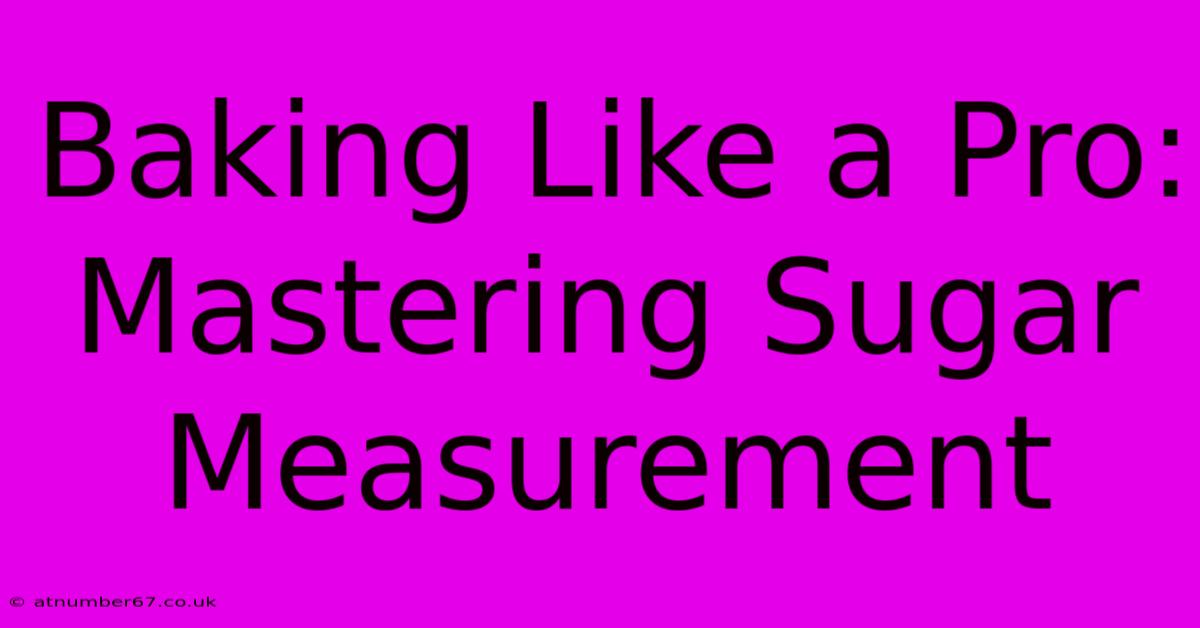Baking Like A Pro: Mastering Sugar Measurement

Table of Contents
Baking Like a Pro: Mastering Sugar Measurement
Baking is a science, and precision is key. While many recipes might seem forgiving, the truth is that even minor inconsistencies, particularly in ingredient measurements, can significantly impact the final product. This is especially true when it comes to sugar, a crucial component affecting texture, moisture, and sweetness. Mastering sugar measurement is the cornerstone of baking success, transforming you from a novice baker to a true artisan.
Why Precise Sugar Measurement Matters
Sugar isn't just about sweetness; it plays a multitude of roles in baking:
- Sweetness: This is the most obvious function. The type and amount of sugar directly influence the overall sweetness of your baked goods.
- Texture: Sugar contributes to the texture of your baked goods. Granulated sugar creates a tender crumb, while powdered sugar yields a softer, more delicate result. Brown sugar adds moisture and chewiness.
- Moisture: Brown sugar, with its molasses content, adds moisture to baked goods, preventing dryness.
- Structure: Sugar helps stabilize the structure of baked goods by interacting with other ingredients like gluten.
- Color: Sugar contributes to the browning and color development of baked goods during baking.
Inaccurate sugar measurements can lead to:
- Stale or dry baked goods: Too little sugar can result in a dry, crumbly texture.
- Cloyingly sweet results: Too much sugar overwhelms the other flavors and makes the baked goods overly sweet.
- Structural collapse: Incorrect sugar amounts can disrupt the structure, causing cakes to sink or cookies to spread unevenly.
Methods for Accurate Sugar Measurement
There are several methods for accurately measuring sugar, each with its own advantages and disadvantages:
1. The Volume Method (Using Measuring Cups):
This is the most common method, but it's also the least accurate. Here's how to do it correctly:
- Use the right tools: Use dry measuring cups, not liquid measuring cups.
- Spoon the sugar: Don't scoop the sugar directly from the bag into the measuring cup. Instead, gently spoon the sugar into the cup, filling it level with the top. Overfilling will lead to inaccurate measurements.
- Level it off: Use a straight edge, like a knife or spatula, to level off the top of the measuring cup, ensuring a precise measurement.
Drawbacks: The volume method is prone to errors due to variations in how tightly the sugar is packed. Different people will pack it differently leading to inconsistent results.
2. The Weight Method (Using a Kitchen Scale):
This is the most accurate method. A kitchen scale measures the weight of the sugar, eliminating variations caused by packing density.
- Tare the scale: Place your empty bowl on the scale and tare (zero) it. This ensures you only weigh the sugar.
- Add the sugar: Add the sugar to the bowl until the scale displays the desired weight.
Advantages: This method provides consistent and precise results regardless of how the sugar is packed. It's especially crucial for recipes that are sensitive to small changes in ingredient amounts, such as macarons or delicate cakes.
3. Understanding Different Types of Sugar:
Different types of sugar have varying weights and densities:
- Granulated Sugar: The standard white sugar.
- Powdered Sugar (Confectioners' Sugar): Finely ground sugar with cornstarch added. It's lighter than granulated sugar.
- Brown Sugar (Light or Dark): Granulated sugar with molasses added. Its weight varies depending on the moisture content.
- Turbinado Sugar: Less refined than granulated sugar; it retains some molasses and has larger crystals.
Tips for Baking Success:
- Invest in a kitchen scale: While the volume method works for some recipes, a kitchen scale is highly recommended for achieving consistently excellent results.
- Use the same measuring method throughout: Consistency is key. Choose one method (volume or weight) and stick to it for all your baking.
- Read the recipe carefully: Pay close attention to the type of sugar specified in the recipe.
- Don't substitute ingredients unless you understand the implications: Substituting different sugars can affect the outcome significantly.
- Practice makes perfect: The more you bake, the more confident you'll become in your sugar measurement skills.
Mastering sugar measurement is a journey, not a destination. By understanding the nuances of different measuring methods and the importance of accuracy, you'll elevate your baking to a new level, consistently creating delicious and perfectly textured baked goods. Embrace the precision, and enjoy the sweet rewards!

Thank you for visiting our website wich cover about Baking Like A Pro: Mastering Sugar Measurement. We hope the information provided has been useful to you. Feel free to contact us if you have any questions or need further assistance. See you next time and dont miss to bookmark.
Featured Posts
-
Abby Chams Age The Story Behind The Success
Apr 05, 2025
-
Youssef Omars Age The Facts Figures And Speculations
Apr 05, 2025
-
Beyond The Headlines Trudeaus Daughters Journey
Apr 05, 2025
-
Fort Worth Weather Week Ahead Forecast
Apr 05, 2025
-
Mark Alcalas Age A Timeline Of Success
Apr 05, 2025
